We have the Dell OptiPlex 7090 Micro as the next unit up in Project TinyMiniMicro. This will mark the last unit of the 10th/11th gen Intel Core units we are likely to look at for some time. With that, we get to see what are the upgrades compared to the previous generation and discuss where Dell stands in relation to its primary competition from HP and Lenovo in this market for 1L corporate desktop PCs.
Project TinyMiniMicro Background
In Project TinyMiniMicro we are purchasing a large number of these devices from different sources. While a standard STH review is of a new product, these TMM nodes occasionally have specs that differ from what one would expect. In all of these pieces, we are going to talk about what makes the nodes unique. We are now well over 40 different nodes to increase diversity. We are testing these on a more circular economy/ extended lifecycle basis to see how they can be deployed after their initial use as corporate desktops. As always, we have a video version of this article.
We recommend opening this video in a YouTube tab, window, or app for a better viewing experience.
For our $735 (before tax and after a partial refund), we received a node with an Intel Core i5-10500T, 8GB of memory, WiFi 6, and a 256GB NVMe SSD. We had originally hoped to get a Core i7-10700T since the unit was advertised as a Core i7, but we found that we had a Core i5 instead sparking that refund. We even got an embedded Windows 10 Pro license which would have cost us around $140 alone. We also got a wireless keyboard and mouse with the unit, a welcome upgrade over the wired units that come standard with most of these PCs.
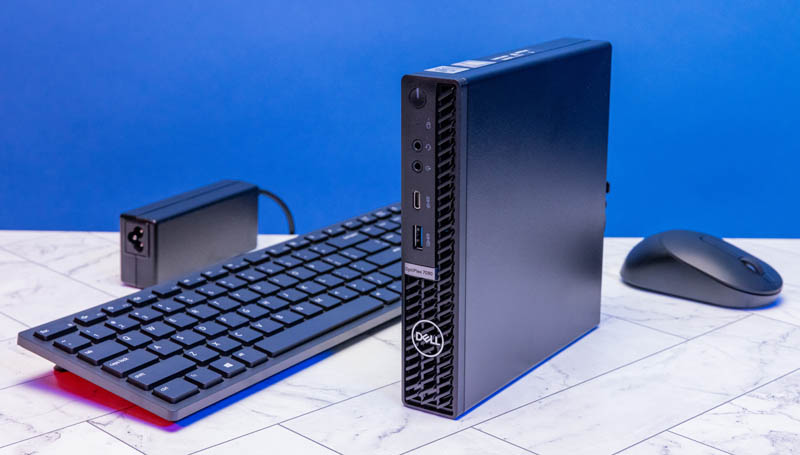
This is part of our series where we are taking a look at some of the newest 10th-11th generation ~1L PCs on the market. With our TinyMiniMicro series, we understand that there is always going to be tension. Older units are less expensive, but unlike buying an old hammer, we get significantly more capabilities and features in new versions. As a result, we have been broadening the base. We have already reviewed the Lenovo ThinkCentre M80q Tiny, M90q Tiny, M90q Tiny Gen2, M75q Gen2 Tiny, M75q Tiny Gen2 (Ryzen 5000 update), and the HP EliteDesk 800 G6 Mini 65W, and 35W version in this generation with the 805 G6 review finished and in the publishing queue and the 805 G8 on order. At this point, we have a fairly good understanding of how these systems stack up.
We are going to go into a quick hardware overview, then into the key specs. We are then going to talk a bit about performance and power consumption before getting to our lessons learned from these units and our final words.
Dell OptiPlex 7090 Micro Hardware Overview
The Dell OptiPlex 7090 Micro is around 1L in size and uses an updated front design compared to the Dell OptiPlex 7070 Micro and OptiPlex 7060 Micro we reviewed previously, and similar to the OptiPlex 7080 Micro.
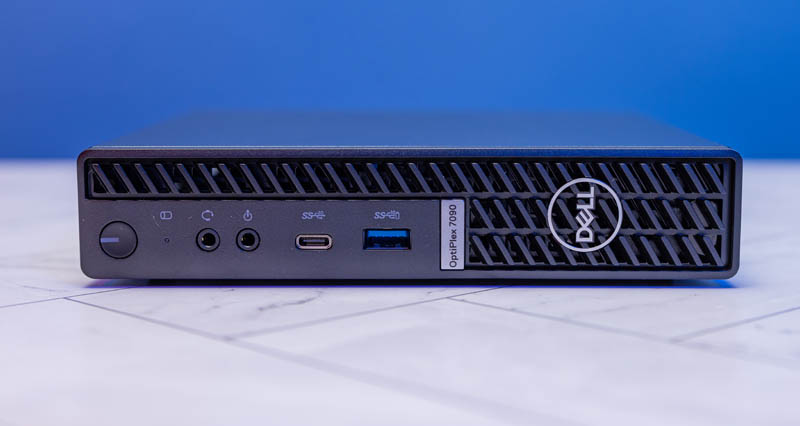
We still get a power button, headset port, and line-out port on the front of the system. As with the 7080 Micro we also get a USB 3.2 Gen2 Type-A port. The big change, and one of the most significant of this system, is that the Type-C port is a USB 3.2 2×2 port that runs at 20Gbps. Hopefully one day we can get a low-power 10GbE adapter with some offloads and utilize that bandwidth. For now, that is mostly going to be the port for high-speed external SSDs.
On the rear of the unit, we get two DisplayPort outputs. Some competitive systems have HDMI and DisplayPort which we probably like better for connecting without an adapter to televisions. We get two USB 3.2 Gen2 and two Gen1 Type-A ports for four total. Dell has an optional slot that one can configure as blank, or get various serial or display outputs. We did not get anything configured in this port. We will note the rear of the units with PCIe GPUs has a different layout in order to accommodate those GPUs. We are also going to talk about this expansion a bit more in our Key Lessons Learned section later.
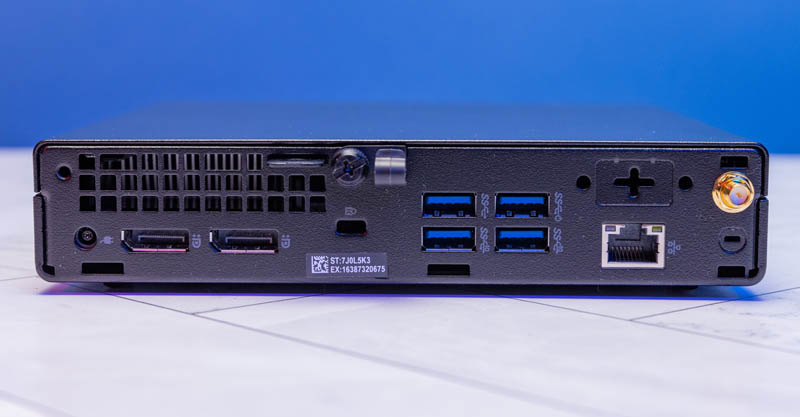
Networking is provided by a RJ45 connector. This is an Intel i219-LM NIC which is important. This configuration is valid for Intel vPro so we need to use this NIC. Given we are seeing on the Intel NUC 11 Pro Review Tiger Canyon NUC11TNKi5 and other systems 2.5GbE, this does feel a bit old even as the current generation since we are in the middle of an update to 2.5GbE in the desktop industry. Intel is now on (at least) its third revision of the Intel i225 NIC silicon, so perhaps that is the reason. Still, we wish that we could get something faster than 1GbE as WiFi is pushing those speeds already.
Inside we have a fairly typical Dell Micro layout. The CPU and memory are on top with the storage on the bottom.
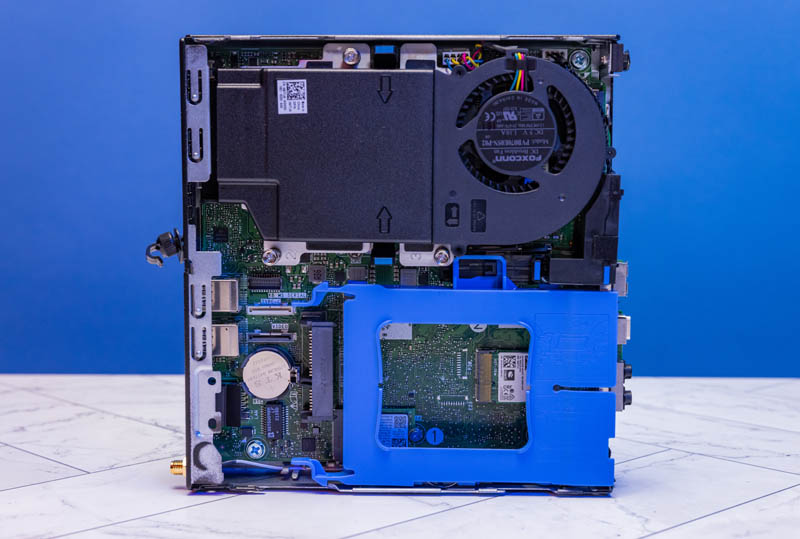
Our unit came with the blue 2.5″ hard drive/ SSD tray. This is a tool-less solution that one can use to install a SATA drive into the system. Dell has the easiest 2.5″ tray in the industry at this point, and a lot of that has to do with the SATA connector.
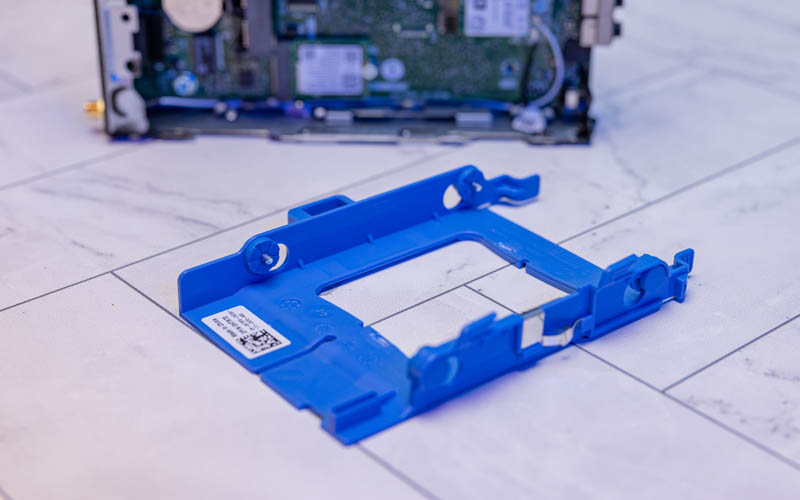
A SATA drive in the try connects to a hard-mounted SATA data and power connector which is a significant upgrade over the HP and Lenovo units that use proprietary cables. This hard-mounted design means that Dell’s implementation is much easier than HP’s and slightly easier than Lenovo’s. It also means, however, that Dell needs a different chassis and motherboard for options with a dGPU, in this generation an AMD Radeon RX 640.
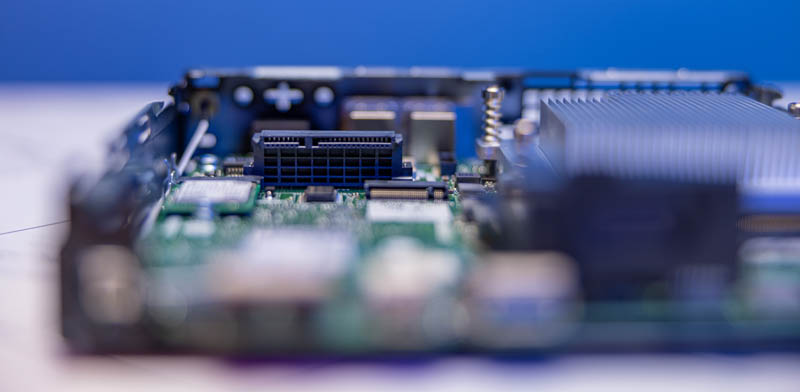
On the bottom of the unit, we have our storage and WiFi expansion. On either side of the WiFi module, there are two M.2 SSD slots. Our unit had a 256GB Western Digital M.2 2230 NVMe SSD installed. It is inexpensive and lower power, but if you want higher performance or capacity, there are other options. We will note that if you have an 11th gen Core processor, you can use one of these M.2 slots with a PCIe Gen4 SSD. One could, for example, use this inexpensive 256GB SSD as a boot drive and then have a larger and faster Gen4 SSD installed for data and applications.
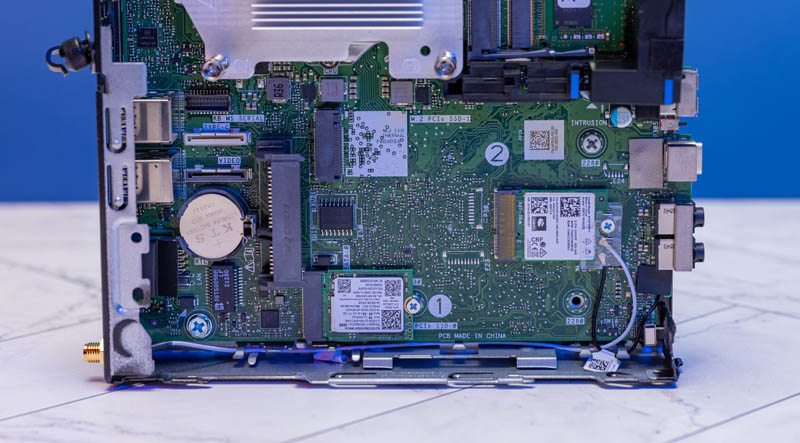
In this system, we had the WiFi option, specifically with the Intel AX201 WiFi 6 and Bluetooth connectivity. WiFi is optional, and Dell has options for other radios, but our advice is to get the Intel AX201 solution installed from the factory. It is much easier than adding this later.
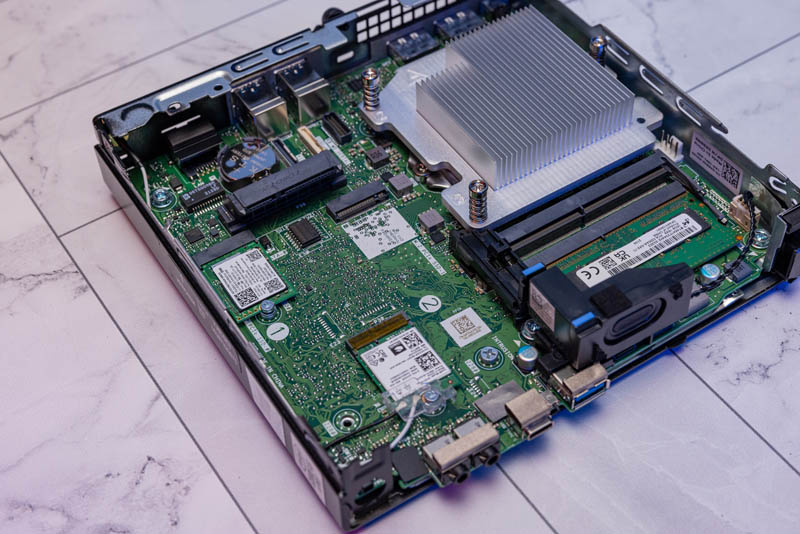
Since we did not have optional rear I/O, the internal I/O headers are present, but not used.
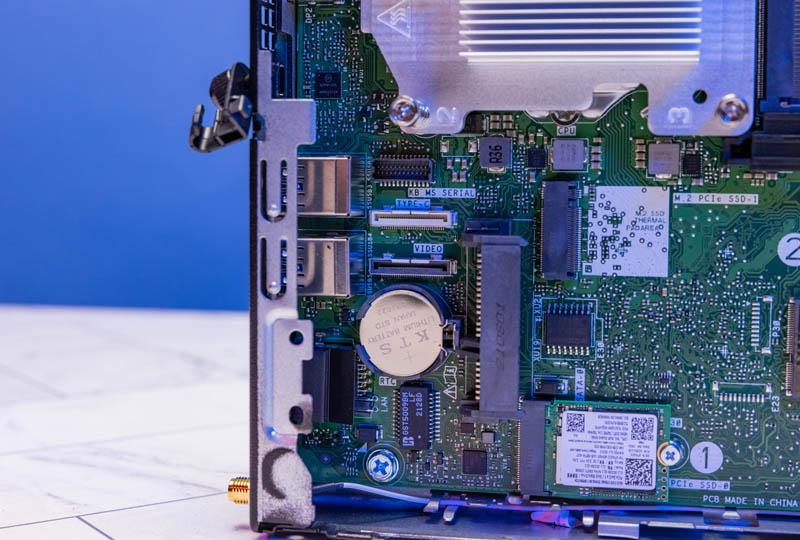
Under the top fan and shroud, we have memory and the CPU. Memory can be up to DDR4-3200 in this generation. We have upgraded this unit to 64GB successfully. Although we have a single 16GB SODIMM here, we would suggest always outfitting this system with two DIMMs for dual-channel memory operation. To access the memory, one has to remove the fan shroud. This is tool-less but it takes longer than on HP or Lenovo 1L PCs.
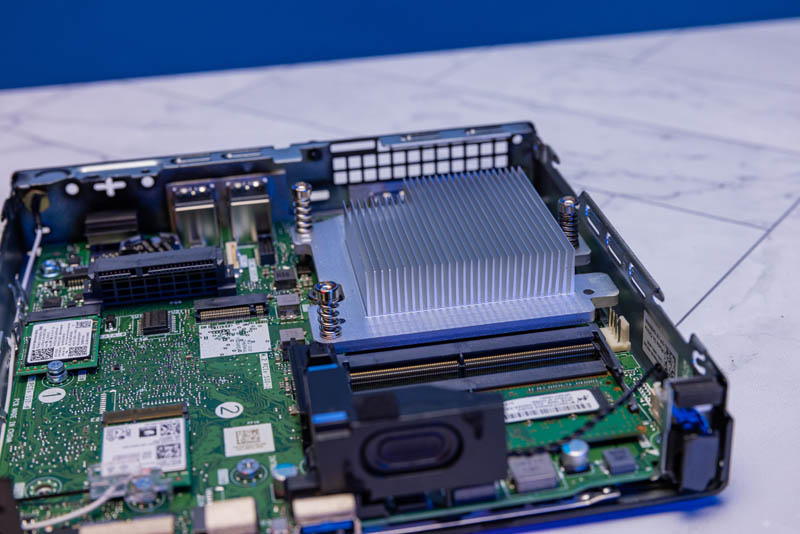
Another upgrade in this generation is the move from the Intel Q470 in the 7080 Micro to the Intel Q570 chipset. Our system is a 35W TDP CPU unit, but Dell offers versions with 65W TDP CPUs that we expect have more robust cooling.
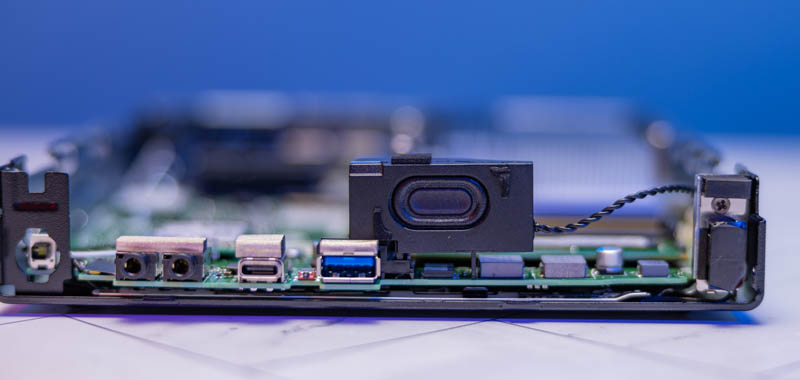
There is a small speaker in this system. Normally we do not discuss the speakers, but the image came back from Nikki who edited this photo with perhaps the funniest caption we have on STH, so it made the cut for this review.
Next, we are going to take a look at the key specs, and performance before getting to our power consumption and final words.

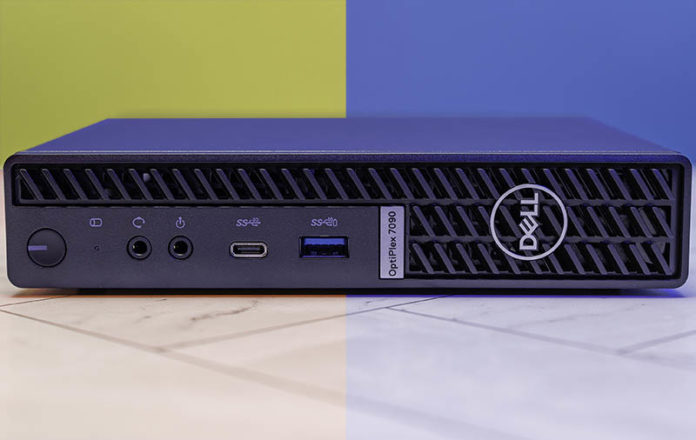


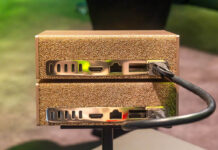
I’ve recently bought 2 used Dell Optiplex 5070 SFF with 32GB for ~$325 each. These have the Core i5-9500 @ 3.00 GHz. I can’t imagine a better computer for the money. These are similar to the 7090 you’re reviewing here but for someone on a budget I think the 5070s are a much better deal.
Totally makes sense Jon. Part of the reason for doing newer models is that today’s current gen becomes tomorrow’s used value node.
Did I understand an i7 model was purchased new from the vendor but an i5 arrived instead? Could such mistakes impact a corporate customer procuring many systems for office use? What if a number of them sat in receiving for a month before the mistake was discovered? Maybe I’m misunderstanding what happened, but anecdotal evidence of this type of mistake seems more important to me than the tests.
Eric – from a reseller not from Dell. It happens. I had the option to return it, but I just took a partial refund instead.
I’ve picked up a 3050 USFF for like 100 € and a 3060 Micro (same 1l format) for 150-ish, both second hand. Very happy with them. Impressive what manufacturers can cram into such a tiny space nowadays, if you see the 2 M.2 storage slots on that 7090 you just reviewed.
has there been any STH peeking at the Intel NUC P14E compute unit 11th to 12th gen upgradeable laptops?
if you haven’t been able to get a hold of any come April’s fiscal close, we could route some SKUs by you without any big hurry I am pretty sure that’s possible because this is a product that we think that we really want to help to survive which justifies pushing the boat out – apologies if out of order for suggestions like this here but it is just what it is nothing more.
I got one for a small esxi box, having issues with two NVMe drives. The 2nd will drop out of bios randomly.
Great review Patrick, thank you.
I’m very interested in fan noise, which you touched on.
Is it possible to adjust the fan profile in the BIOS?
Will it work with 2xM.2 SSDs and 2.5″ SATA SSD installed? Dell lists only configurations with 2 SSDs as supported, but I wonder if it based on thermal/power considerations or there are some chipset restrictions? Would be nice if you try it on practice (just got my 7090, but have no SSDs to try before buying).
Just picked up a 7090M for a client and it has a PCIe slot with an AMD RX640 GPU in place of the 2.5″ SATA option.
I by used 9020/3020/5070s and for the money you can’t get much better than these. My 5070 with i5 9500 w/ 16gb ddr4 and a 300mgb internet connection is as fast as anybody can ask for no matter what the user needs. The micros are slower even with i7 7th gen cpus. There more like a fast laptop speed.
1/12/23 I bought a 7090 new in March of 22. It is the worst POS I have ever bought from Dell. The 2nd video driver didn’t work so they replaced the motherboard. The HD loses data such as the server settings at random times. The new motherboard is jacked up too. So they are replacing that and the HD again. The Firewall settings keep getting dropped too. The 7090 is a LEMON !!
And I love the other 19 Dell computers I have bought over the last 15 years. Don’t buy this POS!